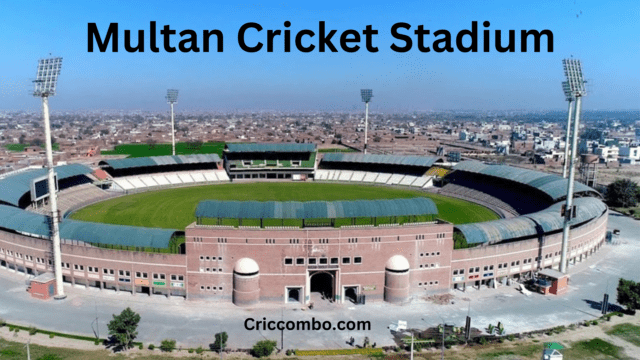The Multan Cricket Stadium, Located in Multan, Punjab, Pakistan, has played a pivotal role in bringing cricket to the city. This stadium has witnessed historic moments, thrilling matches, and the roars of passionate cricket fans. In this article we discuss the history, architecture, capacity, top records and significance of the Multan Cricket Stadium.
Table of Contents
History:
The Multan Cricket Stadium, officially known as the Multan Cricket Stadium-Multan, made its debut on November 25, 2001, when it hosted its inaugural Test match between Pakistan and Bangladesh. Since then, it has become a regular venue for both international and domestic cricket competitions. The stadium has been a witness to the rise of cricketing legends and the fall of many records, making it a cherished destination for players and fans alike.
Capacity & Overview:
Multan Stadium has a seating capacity of around 35,000 spectators. It serves as the home ground for Multan Sultans, a franchise team in the Pakistan Super League (PSL). The stadium has witnessed memorable cricketing moments and hosted various international and domestic matches. The comfortable seating arrangement and sizable capacity make it an ideal venue for cricket lovers to enjoy the thrilling matches held at this historic ground. For the most current information on the stadium’s capacity, it is advisable to check with recent sources or official announcements.
Multan Cricket Stadium Pitch:
The Multan Stadium pitch has a balanced and batsman-friendly surface, offering good support for stroke play. With an average first innings score of around 300 runs in limited-overs matches and 350 runs in Test matches, it indicates a pitch that tends to favor both batsmen and bowlers. In recent matches, spinners have found success, with the ball gripping and turning appreciably. Teams winning the toss might consider batting first to capitalize on the favorable batting conditions, but the pitch tends to slow down later in the game, making chasing challenging. Overall, the Multan Stadium pitch demands a strategic approach from both batsmen and bowlers, ensuring an engaging contest between bat and ball.
Architecture:
The architectural marvel combines modern amenities with a traditional feel, reflecting the rich cultural heritage of Multan. The stadium’s unique structure includes distinct red-bricked exteriors that resonate with the surrounding landscape.
The playing surface at Multan Stadium is meticulously maintained, providing a true and consistent bounce for both batsmen and bowlers. The stadium features world-class facilities for players, officials, and spectators, ensuring a comfortable and enjoyable cricketing experience for everyone involved.
International Matches Records:
The ground has witnessed memorable moments, including remarkable individual performances and team victories.
One of the most iconic moments in the stadium’s history came during the Test series between Pakistan and India in 2004. Multan Stadium hosted the first Test of the series, and it witnessed a historic triple century by Pakistan’s opener, Virender Sehwag. Sehwag’s knock of 309 remains etched in the annals of cricket history as one of the most exceptional innings ever played.
The stadium also witnessed the rise of Pakistani legends like Inzamam-ul-Haq, who scored a memorable century against South Africa in 2003, and Wasim Akram, who showcased his all-round brilliance on multiple occasions at the venue.
Domestic Cricket and PSL:
Multan Stadium is not just a stage for international clashes; it also plays a crucial role in hosting domestic cricket tournaments. The venue serves as a home ground for the Multan Sultans, a franchise in the Pakistan Super League (PSL). The electrifying atmosphere during PSL matches at the stadium adds to the city’s cricketing charm.
The Multan Sultans have enjoyed considerable success at their home ground. The stadium’s role in the PSL has further solidified its status as a cricketing hub in Pakistan.
For more details PSL venue 2024
Key Statistics:
To truly appreciate the significance of Multan Stadium, one must delve into the statistical highlights that have marked its journey through the years:
Highest Team Total in Tests: Pakistan set a record for the highest team total in Test matches at Multan Stadium. In 2006, they scored a mammoth 657/8 declared against the West Indies.
Highest Individual Score in Tests: Virender Sehwag’s historic triple century (309) against Pakistan in 2004 remains the highest individual score at the stadium.
Best Bowling Figures in an Innings in Tests: Yasir Shah, the Pakistani leg-spinner, claimed 7/94 against New Zealand in 2018, securing the best bowling figures in an innings at Multan Stadium.
One Day Internationals (ODIs): Multan Stadium has also hosted numerous ODIs, with the highest team total being 329/6 by Pakistan against India in 2006.
Frequently Asked Questions (FAQs):
What is the seating capacity of Multan Cricket Stadium?
Multan Stadium has a seating capacity of approximately 35,000 spectators.
When was Multan Stadium inaugurated?
The stadium was inaugurated in 2001 to meet the rising demand for international cricket in Pakistan.
What is the significance of Inzamam-ul-Haq’s triple century at Multan Cricket Stadium?
Inzamam-ul-Haq’s triple century against New Zealand in 2002 is a historic moment and one of the most memorable innings in the stadium’s history.
What makes Multan Cricket Stadium unique in terms of facilities?
The stadium is equipped with modern facilities, including advanced dressing rooms, media boxes, and VIP enclosures, blending tradition with modernity.
Has Multan Cricket Stadium hosted international matches other than Tests?
Yes, the stadium regularly hosts both Test and One-Day International (ODI) matches, contributing to its significance in Pakistan’s cricket landscape.
Is there a specific architectural feature that sets Multan Cricket Stadium apart?
The stadium’s architecture seamlessly combines modern amenities with traditional elements, creating a distinctive and visually appealing venue.

